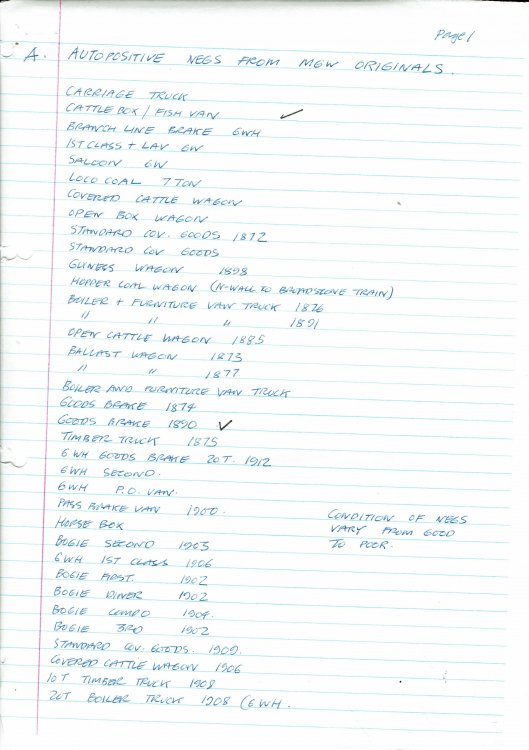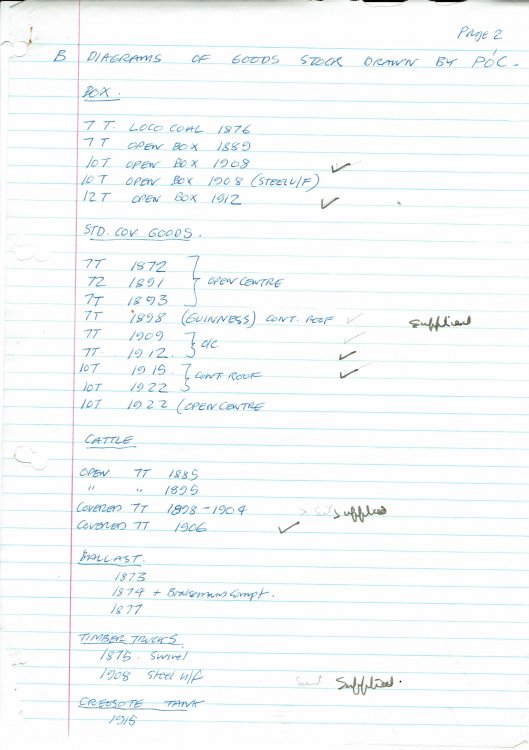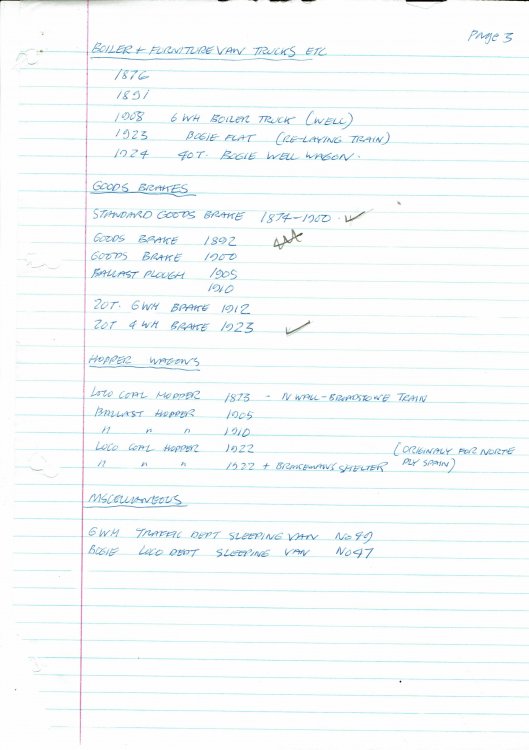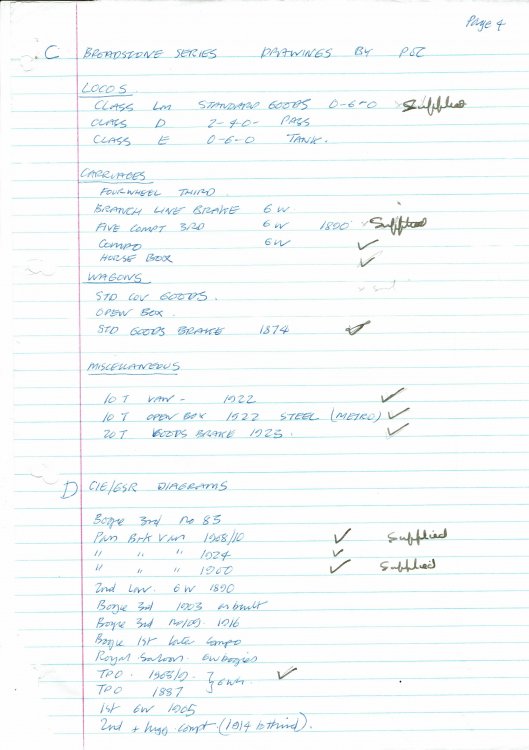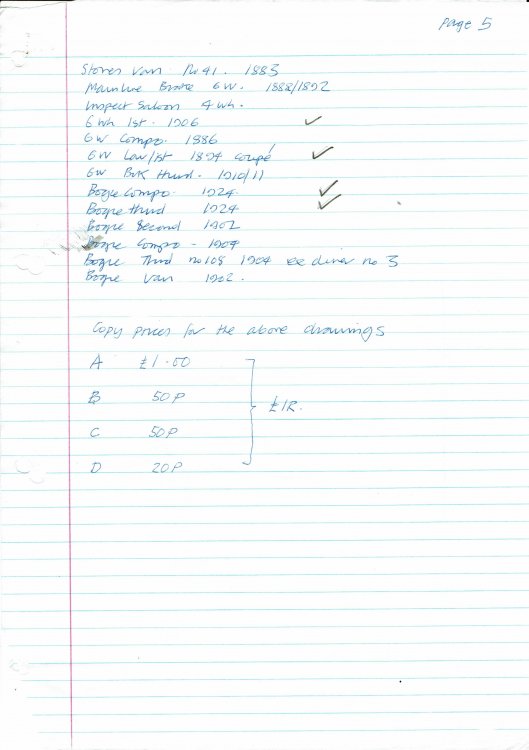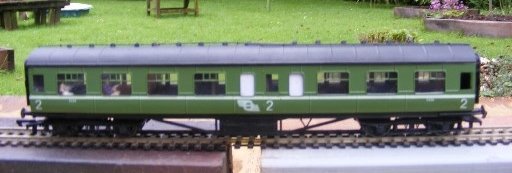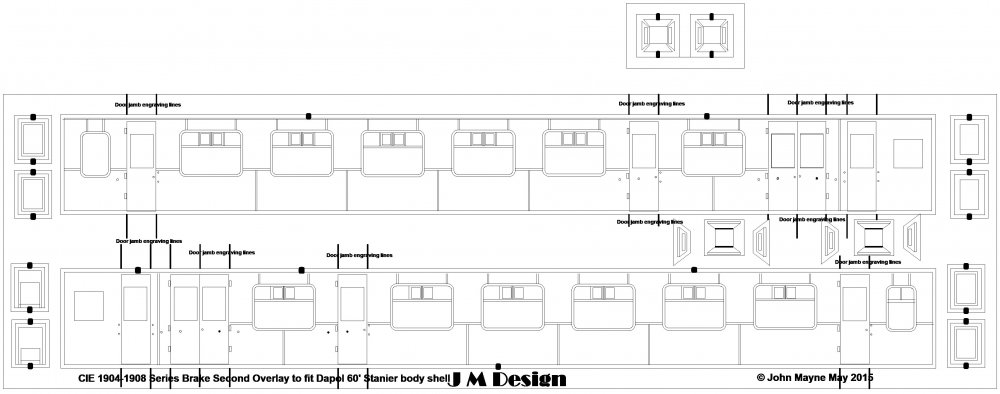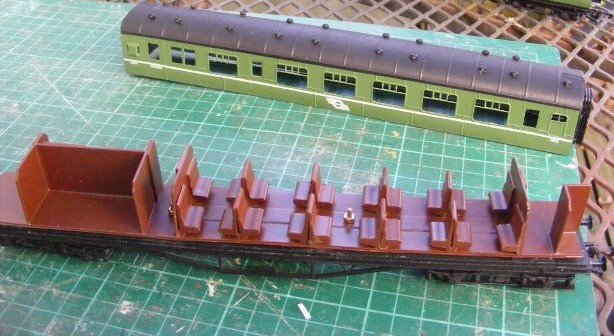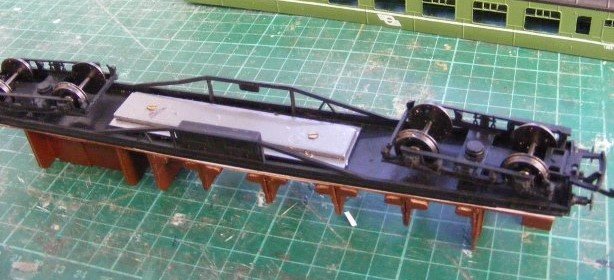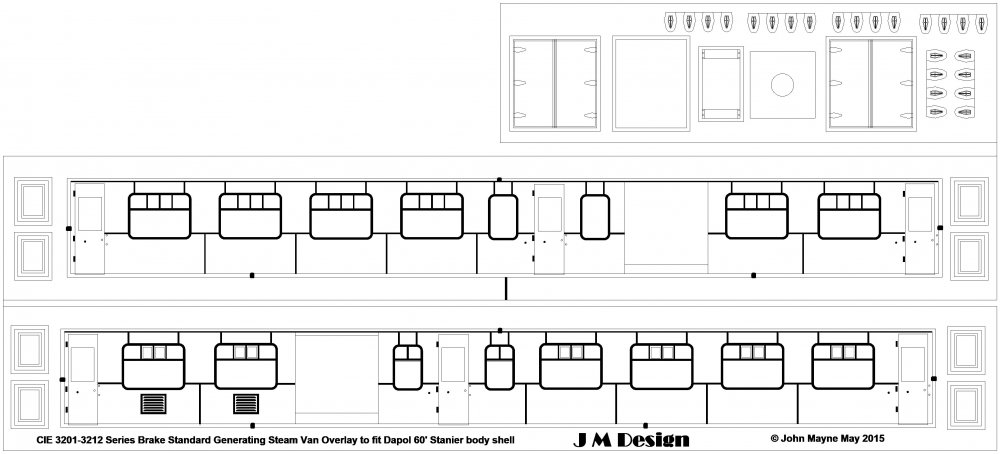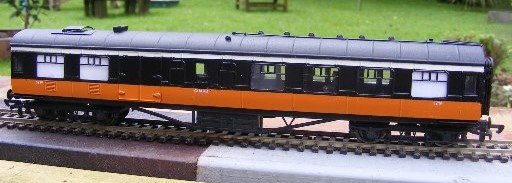-
Posts
4,883 -
Joined
-
Last visited
-
Days Won
119
Content Type
Profiles
Forums
Events
Gallery
Blogs
Community Map
Everything posted by Mayner
-
It looks like an attempt to secure the future of the EM gauge society. The Society have commissioned Peco to manufacture the track, which will be sold to members through the Society store and to the general public at the Societies Expos. Its possible that the society is faced with falling membership as a result of the improvement in the standard of OO gauge rtr models over the past 20 years. A leading British wheel manufacturer recently told me that demand for EM wheel sets and axles had fallen considerably and was planning to discontinue supply once stocks were exhausted, rather encouragingly overall demand for wheels and detail parts remains buoyant and he has recently invested in new machinery It may be that people are content to stick with OO because of the improved running because of improved mechanisms and near universal of NMRA RP25 110 wheel sets compared with what was produced in the 70s & 80s, people who are more concerned about more accurate track and wheel standards are selecting S4 rather than EM. I am not sure on the merits of a 21mm Gauge Society, I think an overall society/lobby group similar to the National Model Railroad Association to represent Irish Modellers broad and narrow in all scales, both to advise on standards and provide a repository for information and potentially models and layouts of historic modelling significance.
-

Narrow Gauge in the Rockies not quite
Mayner replied to Mayner's topic in US / Canadian Railway Modelling
November operating session Tidied up the loco shed after 5-6 years exposed to the Waikato weather. Repaired/replaced window surrounds that had fallen off, re-painted cut checks in door heads so larger locos can fit inside! RGS Motor 6 sits on the turntable. The RGS converted old cars into railcars and an open rail truck in the 1930s, interestingly most if not all of these vehicles survive in working order in the States. The turntable works and is basically a piece of decking board that pivots around a coach screw on some plate washers and has given very little trouble in 8-10 years service. Busy west end of the yard 464 on the main line with a westbound stock special, 463 waits to follow with a way freight while caboose 401 on the end of an eastbound freight waits for her loco to back on once the stock special has departed. Stock special [asses gondolas under the hopper at Utah Junction. Live steam 278 waits to back on to her train once the stock special has departed and the main line clear for running. Slightly scorched smokebox door, these engines were the Rio Grande equivalent in size and power to the J15, the larger 2-8-2s were introduced from the early 1900s onwards to reduce freight train running costs and probably helped keep the remaining narrow gauge lines open into the 1960s. The nearest to conventional baseboard construction, this section of track is supported on 3/4 construction ply on 4X2 treated timber framing and slopes in one direction to help drainage and avoid puddling. Pond lining is glued to the ply with contact adhesive in a similar manner to membrane roofing ballast and ground cover (8mm to dust screenings) is glued to the membrane with a PVA concrete bonding agent, moss is starting to die off with warmer drier spring weather. I am extending the siding on the right out over a dwarf wall which include what look something like coke ovens. This area is normally shaded with sun only in late afternoon during spring,summer, autumn months. 463 has added tonnage to her train since her last stop and has just picked up two gondolas from the hopper and is probably 2-3 carsover her weight limit for the 3-4% gradient to the covered storage tracks in the shed. -
Interesting similar in general appearance to the H Class except for the cab profile and smaller driving wheels without crankpin splashers. The H Class 2-4-0s were the 1st GNR passenger engine and supposed to be based on an older Dublin and Belfast Junction Railway design. The Ulster, Irish North Western and Dublin and Drogheda were also likely to have used 2-4-0s for passenger work, so the origin of the G Class might take some digging/research The GNR would have used the best of the pre-amalgamation types until there was a need to replace them with more modern locos. Interestingly the GNR introduced the 1st batch of 5 U Class 4-4-0s for secondary work in 1915 possibly replacing the G Class locos on the Irish North Western Line and other secondary routes.
-
MGWR 6w coach kits are on the to do list, I need a couple of trains for my own use. I released kits for the 1889 Horsebox and Meat/Fish Van 3-4 years. The frets for the Horsebox and Meat Van are available to order, most of the castings are available from Dart Castings in their MJT range. Drawings of the MGWR brake 3rd, 4 compartment composite and 5 compartment 3rd appeared in Tim Cramer's series in Model Railways magazine in the mid 70s the composite & 3rd were drawn to 4mm scale but the brake 3rd appeared to be closer to S Scale! I will post a "Broadstone Collection " drawing of the brake 3rd in the resources section, the MGWR was fond of goods brakes with raised lookouts until the introduction of the more conventional 20T goods brake with end verandas in the early 1920s
-
The late Padraig O'Cuimin was the recognised authority on the Midland Great Western and published papers on MGWR coaching and wagon stock in the IRRS Journal in the early 1970s. The paper on wagon stock goes into considerable depth on the evolution of both the "standard Irish convertible wagon that carried both livestock and general goods and the evolution of the Irish Cattle wagon. Basically the railways were forced by the Government to increase the length of convertible and cattle wagons to 14' in the late 19th Century which remained the Irish standard until CIE introduced the longer KN wagon in the 1950s. The GSWR & GNR had large fleets of 14' cattle wagons. The MGWR was a thrifty railway and had a relatively small fleet of cattle wagons, relying on the convertible wagons to handle traffic peaks from the big cattle fairs in the West of Ireland, rather than a large fleet of cattle wagons that were only used occasionally. Unfortunately I don't have the full collection, I will scan and post the drawing marked with a √ to the resources section of this site. 1993 prices quoted by Padraig! The Broadstone Series drawings were AO sized, unscaled, highly detailed and a work of art.
-
Peco are a long way behind other manufacturers in terms of EM track and pointwork. Reasonably priced EM gauge bullhead flexible track has been available from a number of manufacturers for the last 20-30 years, the lack of ready assembled points are less of an issue in EM & S4 for bullhead track as the railway and modelers tend to build custom built formations to fit the available space. Its difficult to see the 10-20 people in the world who work in 21mm having the same level of influence on manufacturers as the EM or S4 Societies. For the average 21mm gauge modeler building/assembling locos and stock and laying track is funner than sitting on a standards committee, which is why nearly every one of us works to their own personal track and wheel standard.
-
Reasonably priced Unimat's come up on e-bay https://www.ebay.co.uk/itm/UNIMAT-3-LATHE-AND-MANY-MANY-ACCESSORIES-CLOCKS-MODEL-ENGINEERING/283247594252?hash=item41f2df4b0c:g:eO8AAOSwnFpb4Xe7 The Unimat 3 is a much more solid machine than the older SL1000 though either type are more than adequate for small scale modelling. The only warning is that you will probably endup spending more on late/milling machine accessories than you spent in buying the machine in the 1st place.
-
The Ulster Folk & Transport Museum have loco and rolling stock drawings from the majority of the Broad and Narrow Gauge railways including GNR(I), NCC,(broad & narrow gauge) BCDR, DNGR, CDRJC and UTA that operated in Northern Ireland. I don't know if the drawings are available to members of the public, but it would be worth while contacting the curator to check on the current position. I have a copy of a 21 page catalogue I got from the museum several years ago, the GNR(I) section contained 87 diagrams of coaching stock and a similar number of freight stock, but no locomotives. CDJR, NCC, BCDR diagrams covered locos and stock. UTA drawings naturally covered railcars and railcar conversions. Irish Railway Record Society Members Brendan Pender and Herbert Richards published the GSWR Carriage Diagram book over 40 years ago, a copy of the book may be available in the IRRS Library or through the IRRS London Area The diagram book contains 59 Diagrams of Bogie stock, 40 diagrams of 6w stock, 13 diagrams 4w stock (non passenger coaching). Richard Chown relied heavily on manufacturers drawings for his 19th Century locos and rolling stock used on Castle Rackrent. UK technological museums like the NRM, Manchester and Newcastle may have original general arrangement and construction drawings for narrow gauge stock supplied by companies like Pickering, Metropolitan Carriage and Wagon.
-
I toyed with the idea of buying a lathe and a milling machine a few years ago and ended up buying a Unimat SL. Manufacture between the mid 1950s and mid 1970s the Unimat DB200-SL1000 was a popular for light modelling work as they can be set up to operate as a milling machine, a lathe and other machine tools. The motor in my Unimat appeared to give up the ghost in June, refusing to run and sparks coming out of the bottom of the motor housing. Luckily enough a local re-wind/electrical repair shop was able to do a repair, it looks like a radio interference suppressor blew up causing one of the motor leads to wrap round the commutator, but not trip the workshop circuit breaker. I set up the Unimat as a lathe last night to reduce the bogie center height on a number of large scale archbar freight trucks. When I replaced LGB & Bachmann freight cars with 1:20.3 (15mm) scale stock over the past few years, I was surprised at the variation in coupler height among AMS/Accucraft freight stock. My stock is a combination of new and used with a variation in height between different types of stock, but more surprisingly between cars of the same type. On checking the coupler height of 3044 was 2.6mm higher than the car on the left and the majority of box and stock cars. Coupler height was lower again on gondolas (opens) & flats but that's another story with an easier solution. I will probably stick to AMS couplers rather than change to Kadee, magnetic uncoupling does not really come into it when you have working coupler lift bars and switch stands, though switching or running round trains can involve a lot of walking on my railway if you don't plan your moves in advance The car on the left has a more recent design of truck with a lower bogie pivot center and different brake hanger design. The archbar trucks are of a similar design to the modern American 3 piece freight truck and the BR "Ridemaster" bogies. Lowering the height of the bogie/truck center. The truck center beam/bogie bolster just about fits in the 4 jaw chuck and clears the lathes bed bars. Centering the center beam was simple enough gradually adjusting the jaws using the lathe tool as a guide. The center beam was close to the limit for the SL in terms of diameter, though rising pieces are readily available for the head& tail stocks and tool post. GSWR 6 wheeler in the background waiting its turn through the paint shop! Before and after shots of early version of AMS archbar trucks, the truck on the right is from a gondola that may have spent more time in a box or display case than the truck on the left. Die casting appears to be of good quality min 12-15 years since manufacture, machined reasonably easy with a good finish. Current design of AMS archbar truck, truck center 2.6 mm lower than earlier design, underslung brake hangers, plated wheels. This basically completes the coupling height adjustments to the AMS stock, the next job is to fit Kadee or AMS couplers to my Bachmann locos and freight stock. Another step closer to reliable operation
-
Atkinson Walker built 25 geared steam locos mainly standard gauge for use in industry. The CVR tractor appears to have been the only one considered to be a failure, possibly CVR loco crew lack of familiarity with firing vertical boilers rather than any inherent failings with the loco itself. http://glostransporthistory.visit-gloucestershire.co.uk/ROD_Universal Works_British steam.html. Atkinson-Walker appears to have gone out of production as a result of the Depression and competition from Sentinel. The Atkinson-Walker business re-emerged in 1933 as Atkinson Lorries a successful British heavy vehicle manufacture, not sure if there was a connection with Walker Bros of Wigan who built diesel railcars from the 1930s onwards.
-
I remember seeing a very smart looking 019 newly painted in the tippex scheme with points loco during a visit to Inchacore during the early 1990s The loco appeared to have been overhauled and re-painted including bogies, but never re-entered service being stored in 010s former resting place outside No1 Diesel. Its possible that it was intended to retain a number of 001 Class for Tara and Liner workings before IE got funding to increase the order of the 201 Class from 10 to 34 locos. Only one cab and about 3/4 of the loco body was repainted for the mock up the remainder of the loco remaining in the tippex scheme.
-
It looks like the loco is in an approximation of SNCB/NMBS (Belgian Railways) livery. The model appears to be based on the German V200 diesel locomotives, there were broadly similar locos in use throughout Europe the Irish assembled V200 seems to have been available in British Rail, Belgian, Danish, German, Norwegian, and Spanish railway liveries.
-

CIE Laminate Coaches - Worsley Works - ECMbuild in 4mm
Mayner replied to murrayec's topic in Irish Models
CIE used BR style Commonwealth bogies with 8'6" wb under a small number of Inchacore designed & built coaches in the early 1960s. No one produces a kit or a RTR model for these coaches which had a different end profile to the Laminate stock. The earlier Commonwealth bogies used under Laminates, Parkroyals and some MK2 Bredin coaches had an 8' wheelbase. The other major difference between Irish & BR practice was that CIE used 3' diameter wheels with commonwealth bogies while British Railways used 3'6" which can affect the ride height if you plonk a Park Royal or Laminate on Bachmann bogies. Eoin's bogies remind me of my 1st visit to Inchacore in the late 1970s, where CIE were flame cutting replacement drop equalisers (flat lower part) for Commonwealth bogies. I formed the roofs for the JM Design vans in a similar manner to Eoin using a commercial photo engraver rather than CNC milling to form the weather strips and cantrail. I pre-form the roofs using a G.W.Models Rolling Mill and less sophisticated version of Eoin's clamping and bending jig Eoin I think you should pass this article and your photos to Alan Doherty and New Irish Lines it definitely surpasses my article on assembling Worsley Works Coaches and might motivate Alan to produced an etched roof for his Laminates & ParkRoyals -
A small number of coach side overlays to fit the Dapol 60' Stanier Coach are now available from stock: CIE 1339-55 Side Corridor 3rd/Second/Standard overlays $32.00 NZ Min shipping/ postage $17NZ on orders JMD Corridor 2nd fitted to Dapol 60' Stanier 3rd with with MJT roof vents, 0.45mm AGW straight brass wire plumbing, Hornby coach wheels, modified Dapol interior. 1904-1908 Brake 3rd/Second/Standard Open overlays $32.00 NZ Min shipping/ postage $17NZ on orders 1904-1908 Bk2nd fitted to Dapol Coach, MJT roof vents, 0.45mm AGW straight brass wire plumbing, Hornby coach wheels, Comet interior kit. Weights fitted under floor. 3201-3212 BSSGV overlay kit $53.00 NZ. Min shipping/ postage $17NZ on orders. BSSGV spec as per Corridor Standard. Combination of Dapol interior to passenger & lavatory compartments and plasticard floor and partitions in van portion. Buffet and Standard Open overlays are available to order 6-8 weeks lead time. Please P.M or contact JM Design at majral@xtra.co.nz if you are interested.
-
Kilfree Junction 1956 or 1957?. Apparently A44 was routed into the loop at Kilfree was unable to stop crashed through the buffer stop at the end of the headshunt (on the right) rolled down the bank and wagons piled up on the loco. Apparently Bulleid visited the scene by helicopter and was impressed at how his triangulated wagon underframes stood up to the collision. There were several near misses & run aways during the 1st few years of diesel operation as former steam drivers adjusted to the freer running and increased stopping distances with the new diesels.
-
1100&1100 were the first reasonably successful medium power diesel electrics designed and built in the British Isles and could be considered the forerunners of the BR Derby & BRCW Type 2 Sulzers. The British Rail locos and the B101 Class used an uprated version of the engine used in the 1100&1100 and their electrical system was considered superior to the Brush system used in the BR locos. The Inchacore built locos had a very high axleload by Irish standards and were restricted to 50mph as their plate frame bogies were rough riding and hard on the track. The 101 Class BRCW Sulzers were built with an A1A A1A wheel arrangement and fitted with drop equalising bogies to overcome the weight and riding problems of 1100&1101. Metropolitan Vickers may have gone for Crossley diesels in the A & C Class rather than the proven and reliable Sulzer engine to keep within the axle load and weight limits on the Irish system. Shapeways produce CIE Class B Sulzer designed by B Lancer. https://www.shapeways.com/product/PZZCYVXM6/cie-b-class-sulzer-locomotive-oo-scale?optionId=42321334 An Irish modeller built a batch of Sulzers to a high standard several years ago, but there about as rare as hens teeth.
-
Removing the wipers on the secondmans side seems to have been a common feature on both the A & C Class during the mid-late 1950s. Metropolitan Vickers electrical equipment had a very good reputation a factor that worked in favour of re-powering rather than replacing the Irish Metrovicks Possibly an economy measure to save on maintenance and stock up on spare parts when Todd Andrews was running the railways? There is the story about CIE removing half the light bulbs from the C&L "Bus Coach" as an economy measure during the same period.
-
Its possible B233 went straight from the black to the Supertrain livery. Maybe IRM will do the C Class for their next loco including the B233 & B234 Maybach variation with a porthole blocked out on one side as a puzzler. I always thought B233 looked especially smart in black with white eyebrows and yellow warning panels
-
The authentic Crossley sound! The Australian Metrovicks remained in services with their Crossley engines into the late 1980s on freight and Perth suburban passenger services.
-
O Gauge and larger scales have a great "presence" as exhibition layouts, the sheer mass and momentum of the models means you need to model very little outside of the railway fence, just tracks and trains. Multiple tracks and complex pointwork add to the main line atmosphere, somewhere on the Western Region judging by the buildings and structures.
- 36 replies
-
- 1
-

-
- o gauge model railway
- wexford model railway club
- (and 2 more)
-
A number of A Class appear to have been painted in the high band scheme before the all-black with white eyebrow scheme was introduced. There are photos of A6, 15,16,39 in Barry Carse's book. The tan band on A6 (the guinea pig for the scheme_ almost looks shallower than the other locos or possibly an optical illusion. The low band was originally called the "dipped" scheme in contemporary IRRS Journals may have been introduced like the black to make grime and oil spillage of the flanks of these locos less noticeable. Even the flanks of the re-engined Metrovicks tended to get dirty very quickly compared to the pure bred GM locos, I am not sure if the weathering arose as a result of oil leakage similar to the IC125 power cars in the UK or simply grime washed off the roof by the weather. Possibly a case for a some form of dynamic weathering (smoke unit?) so that the loco becomes increasingly dirty as mileage/time in service build up.
-
The A Class & the Liner Train wagons are a bit of a dilemma to me as I have basically decided to concentrate on modelling the Midland in the steam age before I was tempted by high quality Kato & Atlas American rtr N gauge locos and stock about 30 years ago In a way British and Irish "modern image" models (both kit and rtr) lagged behind the standard of what was available in the the United States and the Continent and what could be achieved by assembling some of the British and Irish outline kits that were available at the time, others were basically un-buildable or only fit for ballast. While the MIR GM diesels and rolling stock kits were reasonably good by the standards of the day and Q kits resin diesels could be built into a reasonable model, there were a few real horrors including a whitemetal A Class possibly produced by MTK for MIR with distorted and porus castings and cab ends with a distinct squint to one side. The IRM A Class seems to lift the standard for rtr locos in Ireland and the UK in a similar manner to Atlas commissioning Kato to produce HO & N gauge locos for the American market which lead the way to twin flywheel center motor drive as the standard for diesel and electric locomotives. Interestingly a lot of the improvements in the hobby are being driven by small businesses like IRM through their enthusiasm and business, rather to established players, thanks to changing technology and procurement methods.
-
Great to see more photos of Greystones, the scratch built locos and stock used on the layout was an improvement of many of the kits that were available at the time. The Cork exhibition brings back memories, interesting to see some familiar faces! The late Frank Davis and I connected and exhibited our EM gauge layouts together at the Cork exhibition. Frank had a nicely detailed Western Region end to end layout, I was in to British outline industrial modelling at the time with a small semi-self contained quarry layout based on the Iain Rice "Bankfoot" plan. Although designed and built in isolation our two layouts connected together and operated together without a hitch apart from one or other of us marshaling a mineral train that was too long for the fiddle yard or run round at the other end. The joint operation turned out to be such a success that Frank exhibited Wentworth and Bankfoot together at Warley after I moved to New Zealand
-
I have the N Gauge version of the CMX, I used to run it around the layout behind the locos in a freight than a special track cleaning train. The most time consuming part was moving other trains about to make sure that all the visible and hidden yard trackage was cleaned. I used isopropyl alcohol as a solvent rather than meths as it did not leave a residue, though it could leave you a little lightheaded in the attic on a hot summer evening. I found running the Clean Machine round the layout about once a month was adequate after a couple of weekly cleans, I have since re-gauged the Clean Machine to run on 12mm or TT track for my Irish narrow gauge layout, but has not been tested as dust is more of a problem than track grime as I seldom run the layout.
-
It would be interesting to work out the comparative costs of producing the parts by CNC milling and photo engraving. I guess the main advantage for both types is the ability to repeat once the CAD file is converted to a CNC or Photo Tool and it saves time involved if forming the part by hand and minimises the risk of error in marking out. The DSER 2-4-2Ts were basically a development of the earlier 2-4-0Ts with a bunker and trailing axle to increase coal capacity. The main mystery is why the remaining 2-4-0Ts were not rebuilt into 2-4-2Ts as their coal capacity basically restricted them to short distance work to Dun-Laoire and Dalkey. Inchacore did not seem to like DSER locos especially the passenger tanks! There is a good account of the late Jack O'Neill's 1st encounter as a fireman with 433 an ex-DSER tank in "A Decade of Steam" he immediately gets off on the wrong foot with the driver by insulting "his engine" by calling it a yoke. One of a number of firemen transferred to Grand Canal Street, redundant as a result of the introduction of AEC railcars on Dublin-Waterford passenger services, no doubt not too happy as result of the transfer form Waterford and suburban passenger work with its frequent stops and starts and cramped cab of a tank loco. Jack seems to have ended his shift impressed with 433 smooth running, free-steaming, haulage ability and speed. Lifting a seven bogie Boat Train off Dun-Laoire Pier and skipping through Blackrock at 50mph. He seems to have enjoyed his time at Grand Canal St as a fireman, his only complaint about the loco was the extreme heat in the cab in Summer.
.png.c363cdf5c3fb7955cd92a55eb6dbbae0.png)



